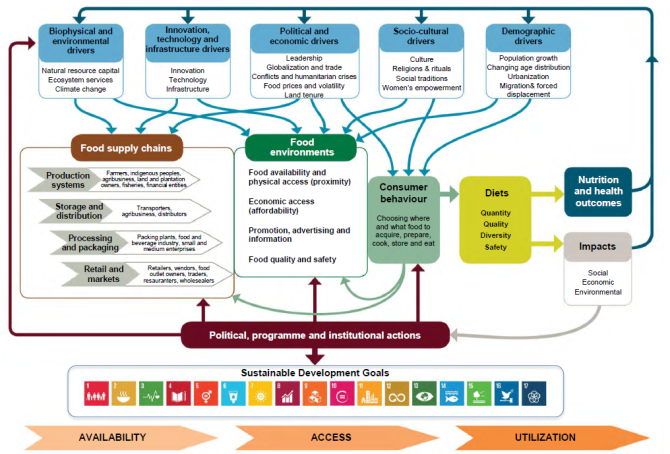Course Details - Food Systems for Healthier and Sustainable Diets
Food systems have a key role in delivering high quality foods but presently do not ensure healthy diets for all, reflected in the high levels of all forms of malnutrition (undernutrition, micronutrient deficiencies and overnutrition) in the world. And this happens in the context of a growing population, urbanization, climate change, increased pressure on natural resources and concerns about the violation of the rights and needs of the more vulnerable groups resulting in marginalization.
There is general consensus that carrying out superficial repairs to the existing food systems will not suffice, and that food systems need to be transformed to sustainably address the societal challenges and move from just supplying sufficient food to providing sufficient high quality diets for all. This requires more than a simple ‘more-food’ approach and particular attention is needed for diet quality and nutrition, the environmental ‘food print’ of production and distribution, and the socioeconomic imprints of supply chains.
Food systems
Food systems looks at all the actors, elements and activities that relate to primary food production, processing, distribution, preparation and consumption and waste disposal; and the socio-economic and environmental outcomes of these activities (HLPE, 2017).
Central in this course is the dietary perspective and which components are related to the diet gaps for different populations groups at national, regional and global level, with a focus on low and middle-income countries. The conceptual framework below, presented in HLPE report 12, shows that achieving sustainable healthy diets is a central goal. This framework is used in the course to explore the three core components of food systems: the food supply chains, the food environment and consumer behaviour and their relationship to the dietary gaps, with an emphasis on the latter two components.

Starting with the existing dietary gaps for different populations we will discuss issues related to consumer behaviour, food environments, food supply chains and drivers at national, regional and global level that are linked to these dietary gaps. We will use a backcasting approach to identify and discuss possible food system actions to be taken to transform the food system for addressing the gaps and how these actions can be leveraged in a sustainable way.
Develop insights & work on your cases
The course is job-oriented and the training approach is interactive, experience- and evidence-based: it provides the participants the opportunity to learn from expert facilitators as well as from each other. Transfer of knowledge goes hand in hand with case studies, working groups, etc. A mix of professionals and students with different backgrounds, yet common interests, will provide a good basis for the exchange of the latest scientific evidences and experiences from the field.
At the end of the course you will:
- Summarize the components, activities and stakeholders of food systems, and their interconnections with sustainable healthy diets;
- Explain the concept of food environment, the drivers of consumer food choices and the challenges and trade-offs in these when transforming to sustainable healthy diets;
- Design a food environment innovation for sustainable healthy diets using food system thinking.
This course is taught in blended format: partially online and partially in person, in The Netherlands
Our courses are currently taught blended and follow this format:
- Online pre-course assignments to ensure that you have acquired pre-required knowledge, understand the technical requirements of the online / hybrid learning.
- Interactive plenary sessions where we share content, facilitate exchanging experiences, challenge each otherthrough debates and discussion. During those interactive sessions we work witha number of online tools like Mentimeter, Jam Board and Mural.
- Group work either online, offline and face-2-face where you with other participants work jointlyto answer specific questions and / or complete an assignment. During theface-2-face part of the course, the content and skills acquired during the online/hybrid part will be applied to a concrete case. Using backcasting eachgroup will be guided and challenged to find innovate solutions for the identifiedproblems, which will be presented at the end of the course.
- Individual assignments where you will read literature, watch videos, do exercises and take quizzes. These assignments are an essential part of the learning and most of them count for getting the certificate. They are meant to introduce or deepen knowledge and make the linkbetween theory and your own situation.
- We offer coaching trajectories where we support you one-on-one or in small groups to review your individual learning paths in the course and help with any basic questions you may have.
The course is taught in partially online and the face-to-face part is in The Netherlands.
Online platforms: Zoom and Brightspace
Internet connection is important for the completion of the course. Not sure about the connection in your area? Send training.cdi@wur.nl an e-mail about your situation.
We use Zoom as the virtual classroom for the online part.
Our learning system is Brightspace. Everything you need — our course programme, assignments, background information are in this system. Brightspace is easy to operate, can also be accessed by your phone and has an on-and offline functionality. To access Brightspace you will receive a temporary WUR account.
We organise a technical check-in before the course starts, to test your facilities and get familiar with the tools.
Course planning and certificates
The course workload is approximately 40 hours a week (full-time).
The exact programme of your course will be available 2-3 weeks before the start of the course. If you’ve successfully completed your course you receive a certificate at the end of the course in the Netherlands.